Not all fats are created equal. When you’re scanning nutrition labels, you may try to limit your intake of fat. But avoiding fat may leave your diet lacking in the types of fat that are actually good for you.
How are you supposed to know what foods contain good-for-you fats? Here’s what you should know:
There are four main types of fat in foods. Two are considered “bad,” and two are considered “good.”
First, let’s take a look at the bad fats — saturated and trans fats. These two types of fat are typically solid at room temperature.
Saturated fats are found mainly in meat and dairy products but can also be found in certain plant foods, such as a coconut, coconut oil and palm oil. Eating too much saturated fat can raise your low-density lipoprotein (LDL) cholesterol levels, which in turn can place your heart at risk.
People in the United States eat many foods that contain high levels of saturated fat. Some common sources include:
- Pizza
- Whole or reduced fat (2 percent) milk, butter and other dairy products
- Meat, including sausage, bacon and beef
- Baked goods
- Mexican food
- Poultry with skin
The American Heart Association (AHA) recommends getting only about 5 to 6 percent of your daily calories from saturated fat. Want that translated?
Take this example:
If you eat about 1,800 calories per day, no more than 108 of them should come from saturated fat. There are nine calories per one fat gram, so you should limit saturated fats to 12 grams per day.
Trans fats come from both natural and artificial sources. While they can be found in some animal products, they are more commonly found in processed foods. Trans fats are a double no-no for your health — they raise your LDL cholesterol and lower your high-density lipoprotein (HDL) cholesterol, the kind that’s good for you.
Trans fats are found in many foods, typically those that contain partially hydrogenated oils. These foods include:
- Fried foods
- Baked goods, such as cakes, biscuits and cookies
- Margarine and other vegetable oil spreads
- Frozen pizza
The AHA recommends limiting your intake of trans fats by avoiding foods with partially hydrogenated oils whenever possible.
But enough about the bad stuff, now let’s talk about good fats — monounsaturated and polyunsaturated fats. These types of fat tend to be more liquid.
Monounsaturated fats help reduce LDL cholesterol and total cholesterol, which lowers your risk of heart attack and stroke. They also provide nutrients, including vitamin E.
Certain foods are filled with monounsaturated fats. To increase your intake, include these foods in your diet:
- Olive, peanut and canola oils
- Avocados
- Olives
- Nuts, such as almonds and pecans
- Seeds, such as pumpkin and sesame seeds
Polyunsaturated fats have many of the same benefits as monounsaturated fats but one bonus benefit. These fats also contain omega-6 and omega-3 fatty acids, which aren’t produced by the body but are essential for good health. Omega fatty acids, also called essential fats, lower triglyceride levels, ease joint pain, lower depression, help with brain development in infants, lower inflammation and may even help protect against dementia.
To amp up your intake of polyunsaturated fats, include these foods in your diet:
- Sunflower, corn, soybean and flaxseed oils
- Walnuts
- Flax seeds
- Fatty fish, such as salmon, mackerel and trout
The AHA recommends that the majority of fats you eat be good fats. Take a look at the foods you eat frequently and see if you can replace the saturated and trans fats in your diet with monounsaturated and polyunsaturated fats.
Heart disease is a leading cause of death among American men and women. Eating a healthy diet, including good and essential fats, is one step in the direction of preventing heart disease. Regular checkups are another. Find a doctor here.







